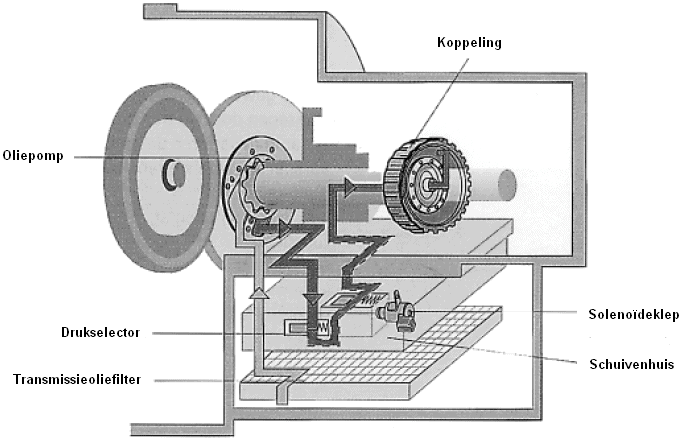Subjects:
- General Information
- Selector lever / mountain gears
- Single Planetary Gear System
- Combined Planetary Gear System (Simpson System)
- System of Ravigneaux
- Gear oil
- Oil pump
- Control unit
- Control valves
General information:
The advantages of the automatic transmission are that the ease of use, comfort and safety are increased. Changing the transmission is done as smoothly as possible, without jerking. The automatic transmission shifts to a higher gear when accelerating slowly than when the accelerator pedal is depressed to the bottom. If the latter is done, then the switch will only take place until just before the rev limiter. When the vehicle comes to a stop, it automatically shifts to first gear.
A fluid coupling or a torque converter is mounted between the engine and the automatic gearbox. See the separate chapter for this torque converter.
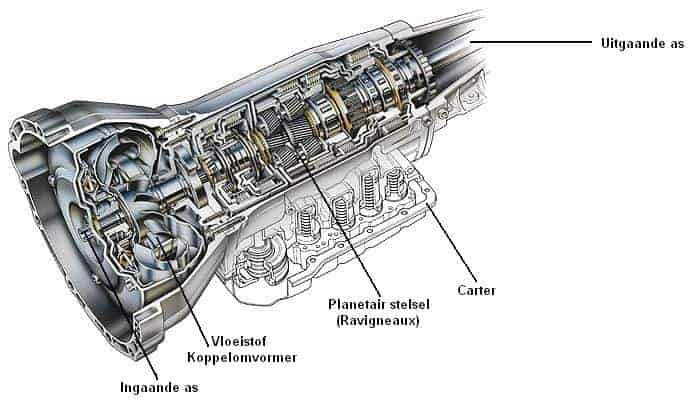
Selector lever / mountain gears:
A car with an automatic gearbox has a selector lever. The selector lever can be operated by first operating the brake pedal. Here's a rundown of what the features it has:
- P: Parking position (The output shaft is blocked, the car no longer rolls and the engine can rev up
- R: Reverse
- N: Neutral (The car is in neutral, the output shaft is not blocked, so with the brake pedal it can roll away
- D: Drive (The forward gear, the car will automatically shift up and down when you accelerate
- *S: Sport (The car will shift less far, so that there is more acceleration when accelerating suddenly)
- *M: Manual (Allows you to indicate when to shift up or down by moving the selector lever forwards or backwards to the + or -.
* is often an option, and is not on every machine.
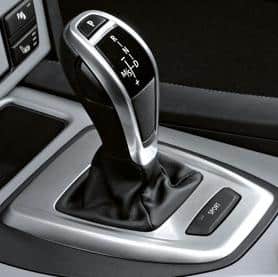
Other car brands use positions L, 2 and 3 to let the driver choose which gear the car should stay in. These positions are also known as the “mountain gears”.
If one of these positions is engaged, the automatic transmission is put in a certain gear and also kept in it. This can be very useful when driving in the mountains. When descending normally, the automatic transmission in position “D” will shift up to a higher gear. As a result, the ratio in the transmission becomes smaller and smaller, so that the car will descend faster and faster. By engaging gears 3, 2 (1 or L), the automatic transmission will shift to a lower gear (from eg the 5th to the 4th stage). The engine will then rotate at a higher speed, causing the car to slow down. There is now no need to brake more and more because there is more braking on the engine. When driving with a trailer, this is necessary on a steep descent, otherwise the brakes will overheat due to the constant braking.
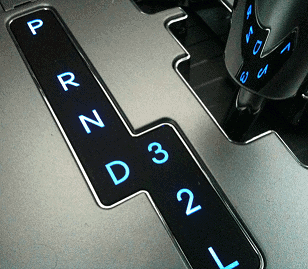
Single Planetary Gear System:
Planetary gear systems are used in several systems, namely in automatic gearboxes, starter motors, overdrives and hub reductions. A planetary gear system consists of the following parts:
- ring gear
- 3 Satellite Wheels
- Carrier
- sun wheel
In order to be able to transfer a torque with a single planetary gear system, the ring gear, the carrier or the sun gear must be secured. This part then serves as a reaction element. The satellite wheels only serve to bridge the distance between the sun gear and ring gear.
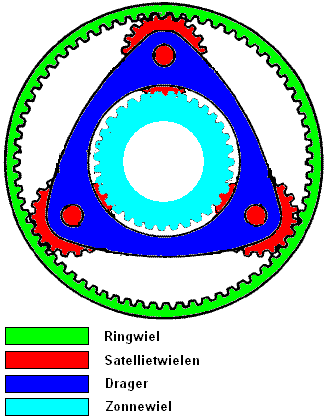
Example: The sun gear is coupled to the engine and will rotate at the same speed. The carrier is connected to the output shaft. The ring gear is fixed to the gearbox housing. This causes a significant delay. That means: The sun gear is driving, the ring gear is the reaction element and the carrier is driven.
The sun gear (light blue, in the middle) rotates counterclockwise. This drives the (red) clockwise rotating satellite wheels. These will turn in the ring wheel and take the (blue) carrier with them.
As a result, the carrier will rotate less quickly than the sun gear. That means the movement is slowed down.
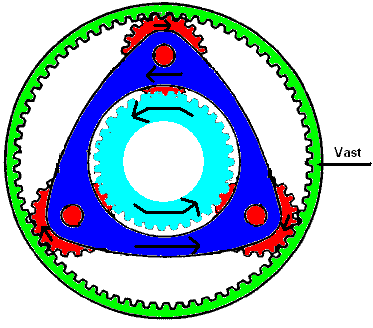
The table shows 6 different transmission options. Not all transmission options can be used in automotive technology. Usually there are only 3 options left.
Brake bands or multi-disc couplings are used to connect and secure the various elements. In this way we can link different elements and there are decelerations, accelerations and changes in the direction of rotation.

In the latest systems, the computer ensures that oil pressure is sent to the multi-disc couplings, so that the parts can be secured. The theory about the brake tires and multi-disc clutches is discussed further on this page.
The figure shows a schematic representation of four sets of planetary gears in an automatic transmission. There are three systems for the forward gears and one for the reverse. The red line indicates the direction of the forces through the automatic transmission; from the left (engine side with torque converter) through the complete part with planetary systems (black lines) to the propeller shaft coupling. Four systems are used in the gearbox, each with a Z, D and R (sun gear, carrier and ring gear).
On the page calculating reductions of planetary gears contains more information about switching planetary systems on and off and linking various systems together.

The planetary gear sets are symmetrical above and below the axis. There's no other way, because the interior rotates while driving.
To help understand what happens when a gear is engaged, powered parts in the image's planetary system have also been highlighted in red.
In the picture, gear 1 is engaged. To engage gear 1, a clutch must be engaged. This link is shown in blue. With the closed clutch and one driven side of the planetary system, one part must also start to rotate. In that case, the sizes of the parts determine the transmission ratio (think of a small input gear and a large output gear; the large gear will then rotate more slowly. If the large gear would have twice as many teeth as the small gear, then the ratio would be 1:2).

In principle, this also applies to the automatic transmission; the sizes of the ring gear, the sun gears, and the satellite gears are different in all four systems. Now you can probably imagine that when another clutch is energized (eg from the system on the left) the speed of the output shaft has changed. Click here for more information on calculating reductions of the planetary gear system.
Combined Planetary Gear System (Simpson System)
In automatic gearboxes, combined planetary gear systems are often used, in which several satellite wheels or carriers are mounted on one sun wheel. This is the case, for example, with the so-called Simpson systems.
The Simpson system has a wide sun gear and 2 ring gears. These ring gears are usually driven, which means that the tooth load is much lower than with a driven sun gear. As a result, the system can often be made smaller. Today the Simpson systems are not used very often. The Ravigneaux system is more popular with developers because it saves more space.
The image shows the planetary gear system as one dense unit. Visible are the ring wheel (The left wide ring with teeth) and the carrier (The silver part).
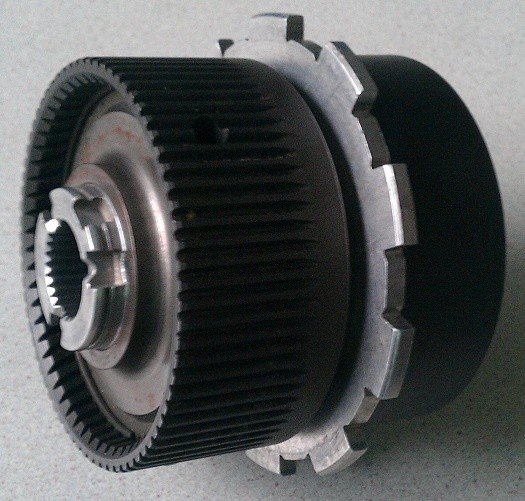
The ring gear has been slid off. Now the satellite wheels and carrier can be seen. The 3 satellite wheels grip on the inside with the sun wheel and on the outside with the ring wheel (which has now been slid off). These gears are always connected to each other.
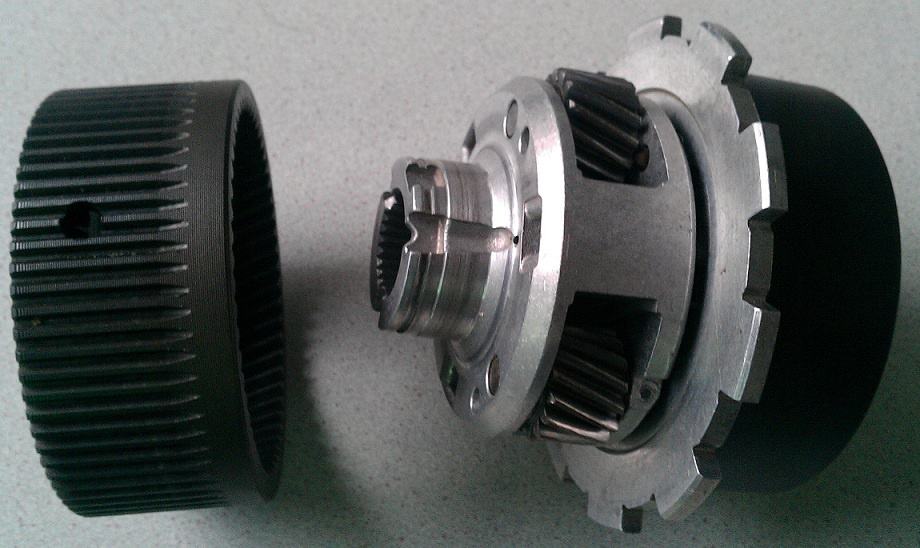
Here the carrier (containing the satellite wheels) has been slid off the sun wheel. The sun gear is the gear in the right part.
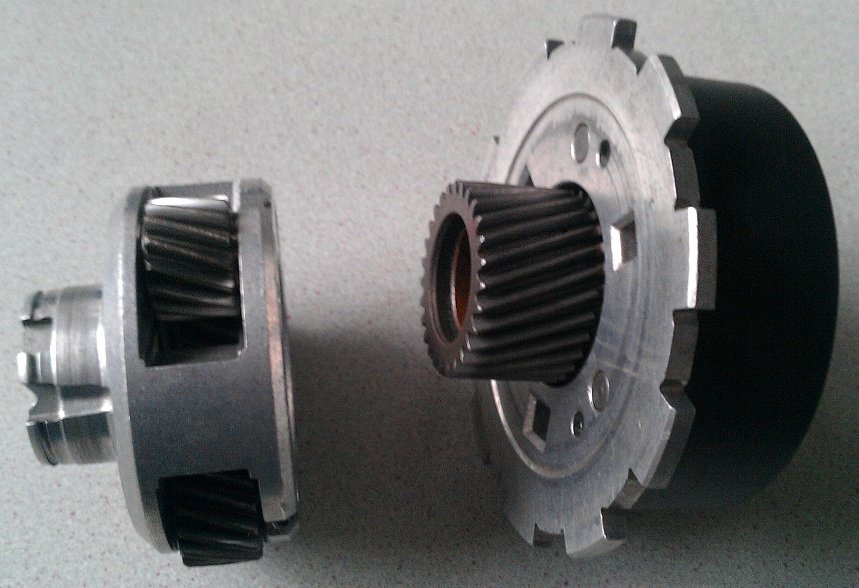
Here you can see the double sun wheel. The left portion powered the planetary gear set seen in the images above. The right cog the system next to it. This gives the name "combined" gear system, or the Simpson system. If the sun gear is single (only the left part) and only 1 planetary gear system is present, this is called a single or Ravigneaux system. The Ravigneaux system has 6 satellite wheels instead of 3 in this system, but that will be explained later.
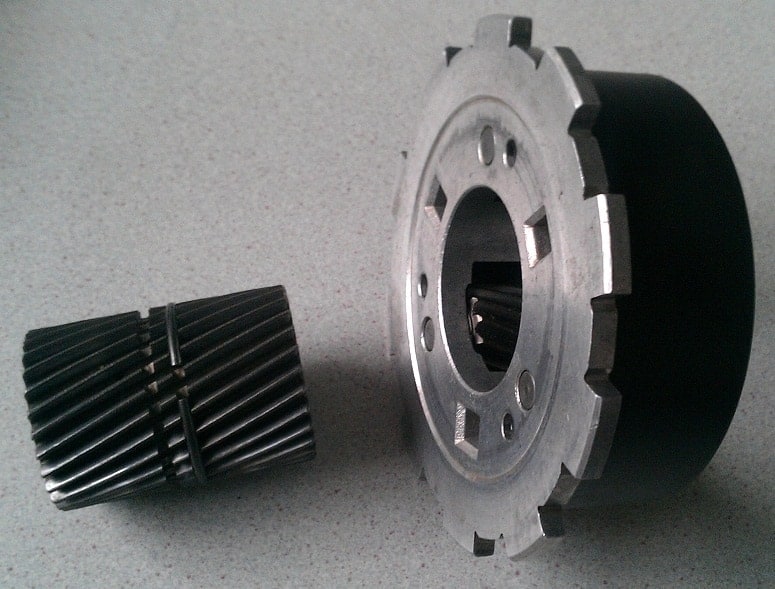
This is the other part of the combined system. The black ring wheel on the left, the carrier with the satellite wheels in the middle, with the sun wheel on the right (in it).
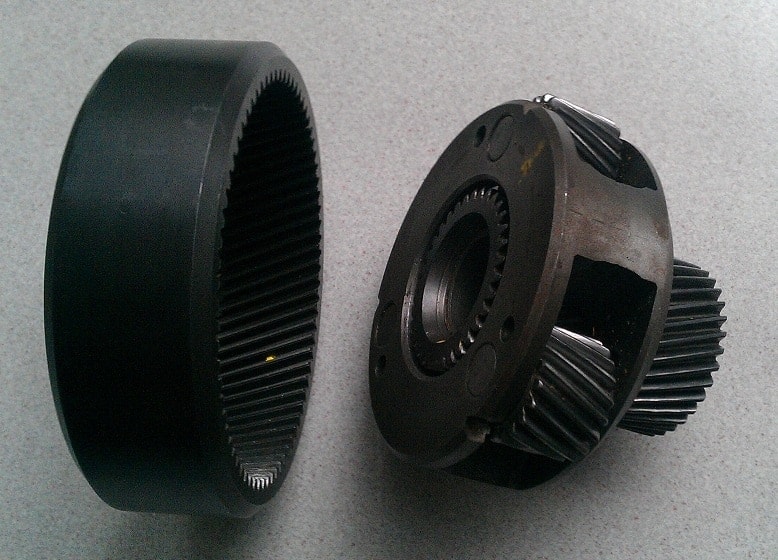
Ravigneaux's system:
At the end of the 20s, the French engineer Paul Ravigneaux developed a compact planetary gear system to easily create several practical transmission ratios. This is called the Ravigneaux system. This system is used today on many automatic gearboxes.
This system is very compact, because 2 planetary gear systems are assembled into only 1 system. It consists of 2 sun wheels, 3 large and 3 small satellite wheels and 1 ring wheel. Here is a side view.
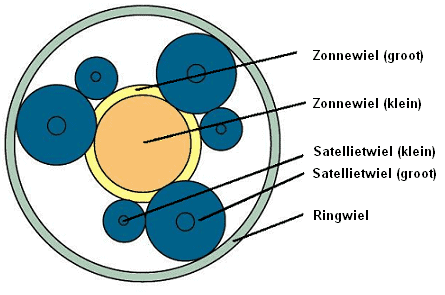
The image below shows the satellite wheels interlocking. The large satellite wheel is connected to sun wheel 1. The small satellite wheel is connected to sun wheel 2.
In the table we see that when the first gear is engaged, clutch 1 (K1) and brake band 1 (B1) engage. This means that sun wheel 2 and the carrier with the satellite wheels are fixed (they are driven). The ring gear is then floating.
This gives the greatest delay. A large deceleration also means an increase in torque and also a low speed at the wheels. 1st gear is the best gear to accelerate from standstill.
When the gearbox shifts to 2nd gear, brake band B1 is disengaged and clutch B2 is engaged. Now sun gear 2 and the ring gear are secured and thus driven. In that case, the carrier is driven. This combination of coupled components gives less deceleration than with 1st gear and gives exactly the right transmission ratio for 2nd gear.
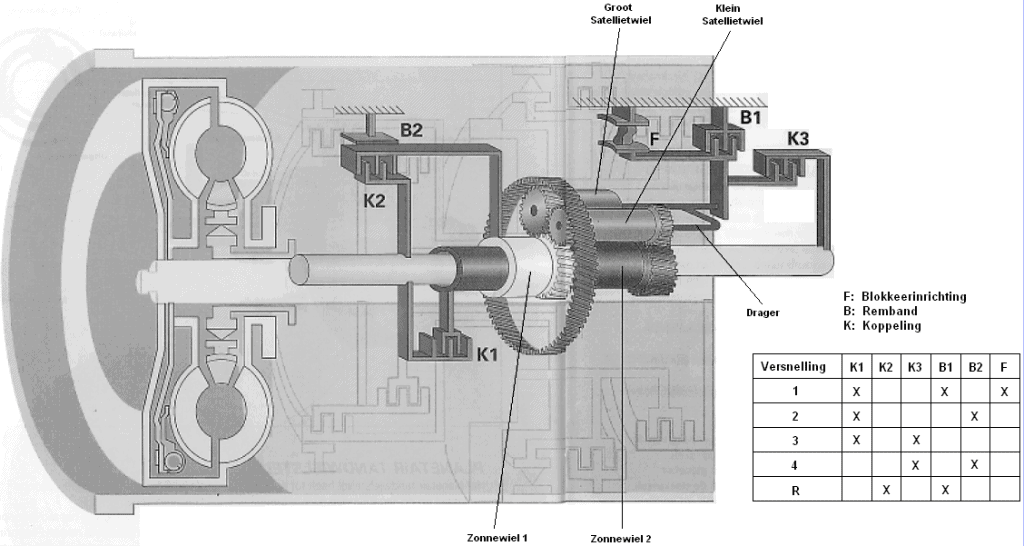
Multi-disc clutches and brake bands:
Brake tires were used on the old gearboxes to secure the various parts (such as the sun gear, the carrier and the ring gear). Brake bands are made of iron and are lubricated to prevent and cool metal-to-metal contact as much as possible. The images below show a brake band (left) and a brake band around the ring gear (right).
By squeezing the brake band with a hydraulic plunger (which extends), the ring gear is secured. Thus, when tightening, a certain part in the planetary gear system is made floating and driven, whereby a gear is engaged.
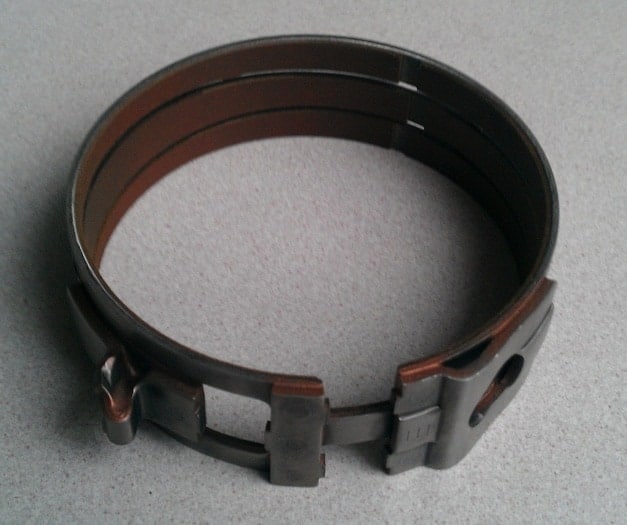
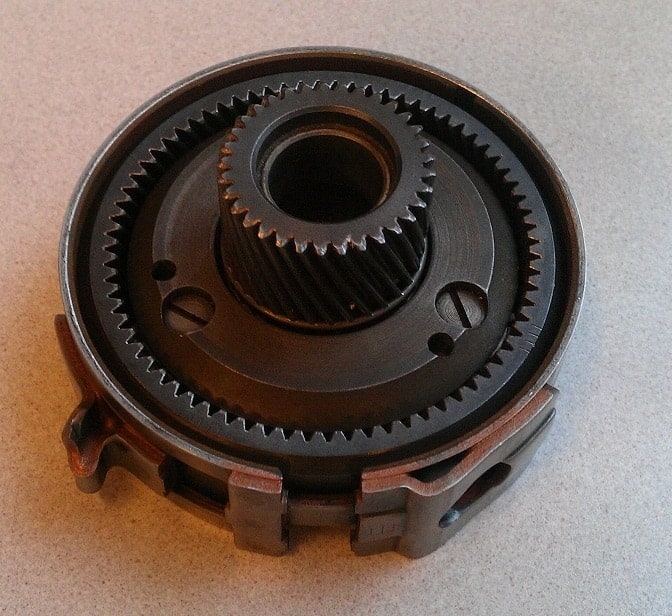
With newer gearboxes, brake tires are often no longer used, but multi-plate clutches. A multi-disc clutch consists of a number of separate clutch plates one after the other, which are pressed against each other with the aid of oil pressure. This “couples” the clutch and secures the ring gear. The images below show the multi-disc couplings in disassembled condition. The parts are pushed together. The teeth of the iron housings interlock.
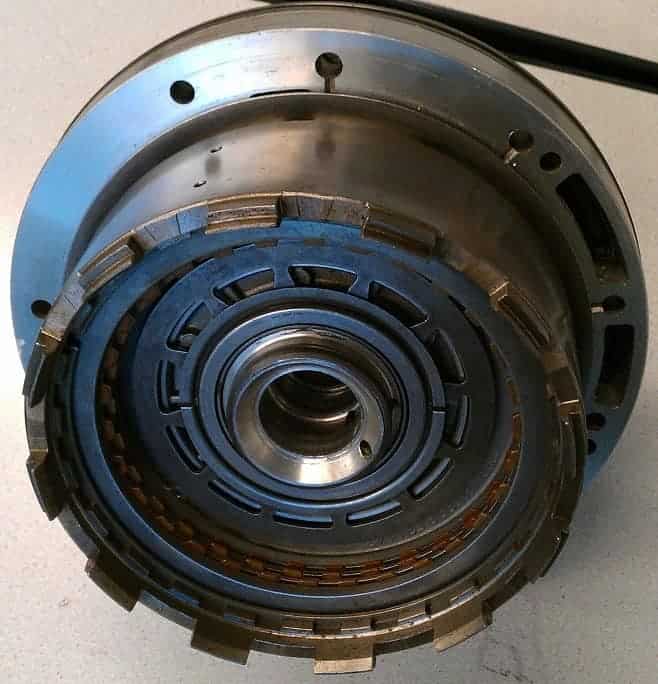
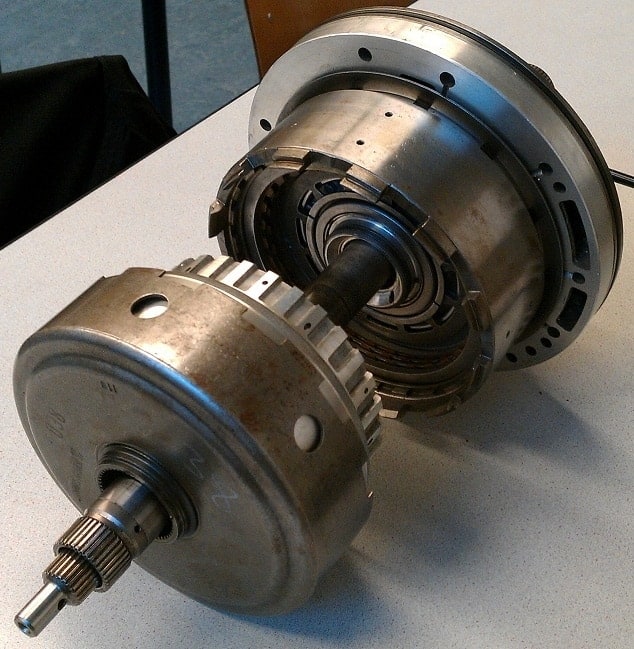
Gear oil:
Automatic transmission fluid is usually of the ATF (Automatic Transmission Fluid) type, but sometimes manufacturers have a different type of oil with different specifications. This is why you should always pay attention to this, because the wrong oil in the gearbox can cause additional wear and premature failure. The oil level of the automatic gearbox should also be checked periodically. Too low can cause the oil to overheat, causing it to age much faster, resulting in increased gearbox wear. Checking the oil level can sometimes be very simple by means of a dipstick, just like when checking the engine oil, but often the bins do not have a dipstick. Then the oil level must be checked by unscrewing the filler plug with the engine running and filling it up until the oil just runs out. Depending on the manufacturer, the temperature must first be checked. Sometimes it has to be done with oil as cold as possible, sometimes with oil between 30 and 50 degrees Celsius.
Oil pump:
A gear pump or a sickle pump is often used in the transmission. The pump in the picture is a sickle pump. This pump is driven directly by the motor. The oil then always circulates when the engine is running, ie in all positions in which the selector lever is located.
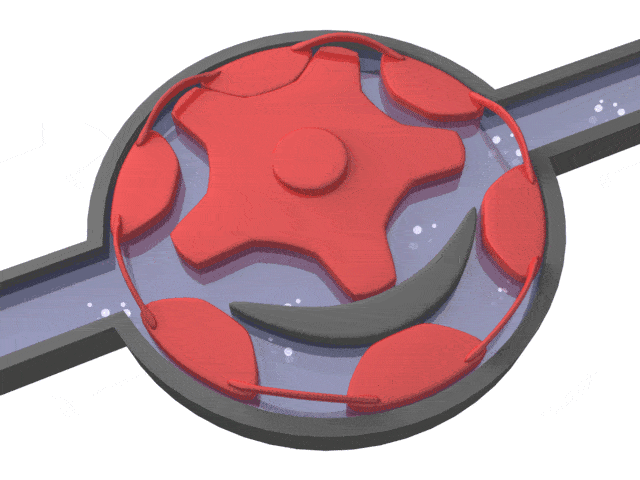
Control unit:
The control unit ensures that the pump pressure is constantly regulated to a base pressure. In addition, the control unit ensures that the control valves switch on and off at the right time.
Control valves:
The control valves are operated by the position of the selector lever. In position P and N, the accesses are closed and the oil drains from all pipes. All clutches and brake bands thus lose their oil pressure and are pushed back by the spring force. When the control unit gives a signal, (eg to lock the ring gear for first gear), a signal is sent to the solenoid valves (also called solenoid valves). When a valve and thus also a slide of the slide housing opens, oil flows under high pressure to a plunger, which supplies the multi-disc clutch or brake band with oil. The pressure selector is a modulating valve that controls fluid pressure based on the accelerator pedal. Due to this oil pressure, a part is secured in the automatic transmission, so that gear changes can be made.
